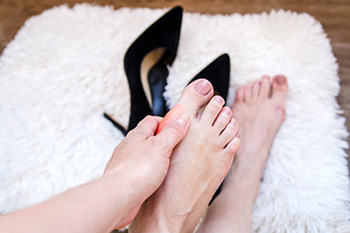
Wearing high heels may look stylish, but it can often lead to painful foot blisters. Blisters form when friction causes the layers of skin to separate, trapping fluid in between. High heels, especially those that are tight or have pointed toes, increase pressure and rubbing on certain areas of the foot, particularly the toes, heels, and balls of the feet. Symptoms include redness, tenderness, and the development of fluid-filled bumps that can make walking uncomfortable or painful. If the blister bursts, the exposed skin can sting and may be at risk for infection. A podiatrist can treat painful or infected blisters safely and recommend ways to prevent them in the future. Treatment options include padding, blister dressings, proper wound care, and advice on shoe fit and foot hygiene. Custom orthotics or cushioned inserts can also reduce pressure in problem areas. If you frequently develop foot blisters, or, if they have become infected, it is suggested that you schedule an appointment to see a podiatrist.
High heels have a history of causing foot and ankle problems. If you have any concerns about your feet or ankles, contact Tanya R. Sellers-Hannibal, DPM from Maryland. Our doctor can provide the care you need to keep you pain-free and on your feet.
Effects of High Heels on the Feet
High heels are popular shoes among women because of their many styles and societal appeal. Despite this, high heels can still cause many health problems if worn too frequently.
Which Parts of My Body Will Be Affected by High Heels?
- Ankle Joints
- Achilles Tendon – May shorten and stiffen with prolonged wear
- Balls of the Feet
- Knees – Heels cause the knees to bend constantly, creating stress on them
- Back – They decrease the spine’s ability to absorb shock, which may lead to back pain. The vertebrae of the lower back may compress.
What Kinds of Foot Problems Can Develop from Wearing High Heels?
- Corns
- Calluses
- Hammertoe
- Bunions
- Morton’s Neuroma
- Plantar Fasciitis
How Can I Still Wear High Heels and Maintain Foot Health?
If you want to wear high heeled shoes, make sure that you are not wearing them every day, as this will help prevent long term physical problems. Try wearing thicker heels as opposed to stilettos to distribute weight more evenly across the feet. Always make sure you are wearing the proper shoes for the right occasion, such as sneakers for exercising. If you walk to work, try carrying your heels with you and changing into them once you arrive at work. Adding inserts to your heels can help cushion your feet and absorb shock. Full foot inserts or metatarsal pads are available.
If you have any questions, please feel free to contact our office located in Owings Mills, MD . We offer the newest diagnostic and treatment technologies for all your foot care needs.
